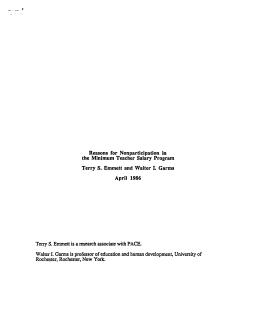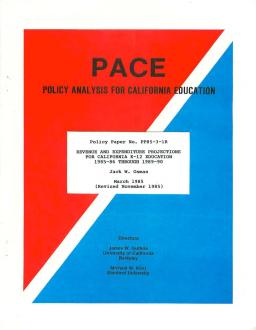1985–86 Evaluation Report
Published
Summary
Peninsula Academies are three-year high school programs designed for at-risk students, combining academic and technical training. Since 1981, they've been operating in California, and in 1985, ten new programs were created under state sponsorship. This report evaluates the quality of implementation and evidence of measurable impact on students after the first year. The report is based on site visits, questionnaire responses, and student data gathered from each high school. The Academy model is complex, but some sites didn't fully realize all components.
Published
Summary
California's K-12 education system has experienced funding instability, with revenues per pupil fluctuating and staying constant for years. The education system is attempting a major program of quality improvements while keeping funding constant, a challenge that may be difficult to maintain in the future. The state gives K-12 education a lower priority than most other states when state revenues are tight. The state needs an additional $7.2 billion in the next five years to maintain the current level of real resources per pupil.
Published
Summary
This study investigates low participation in the Minimum Teacher Salary provision of SB 813, which had previously been reported by the Legislative Analyst. Only a small percentage of funds were claimed for 1983-84 and 1984-85. Researchers surveyed 48 districts in CA, showing a potential mean beginning salary of over $19K by 1985-86. The concern about underparticipation may be unfounded, as a large percentage of districts will participate, while those that do not have reasons. Large districts participate more than small and medium sized ones, and participation in rural areas is increasing.
Waivers and School-Based Program Coordination Under AB 777
Published
Summary
California's waiver authority provides school districts relief from Education Code, allowing them to seek alternatives to state requirements subject to local and state review. Waivers are automatically approved unless denied by the State Board of Education, which rarely happens over local objections. Program waivers are rare despite clamor for needed flexibility, possibly due to districts being unaware of the process, viewing it as time-consuming, or using suboptimal local procedures. Oversight hearings are recommended to explore the potential of the waiver process.
1985–86 Through 1989–90
Published
Summary
Expenditures for elementary and secondary education in California must rise by about 59 percent between 1983–84 and the end of the decade just to maintain the status quo in terms of real per-student spending. This would amount to a K–12 budget in 1989–90 of $21.9 billion. Yet K–12 revenues are projected to grow by only 50 percent (under one scenario) or by about 72 percent (under another). In other words, unless the revenue structure is significantly altered, projected school revenues through 1990 will be inadequate to maintain the same level of spending per student or will increase at a pace...




